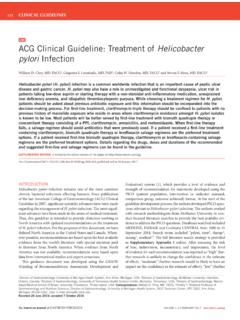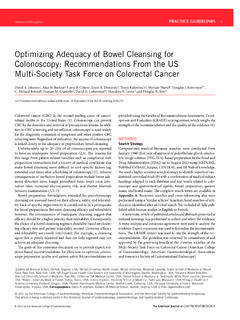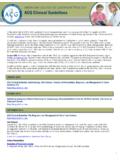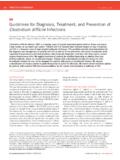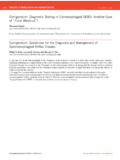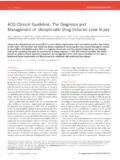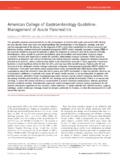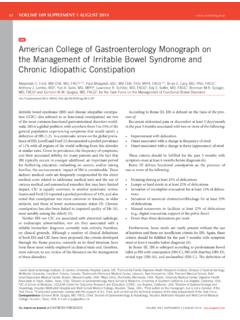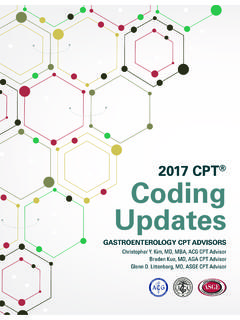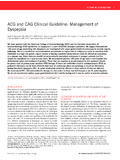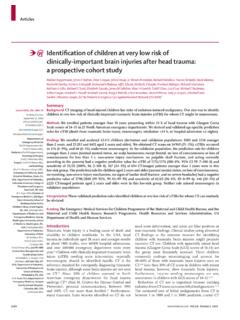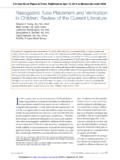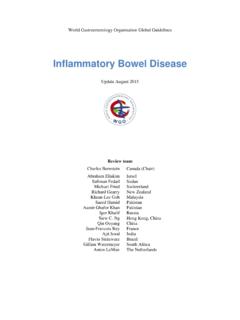Transcription of ACG Clinical Guideline: Epidemiology, Risk Factors ...
1 18 PRACTICE guidelines nature publishing group CME. ACG Clinical Guideline: epidemiology , Risk Factors , Patterns of Presentation, Diagnosis, and Management of Colon Ischemia (CI). Lawrence J. Brandt, MD, MACG, AGAF, FASGE1, Paul Feuerstadt, MD, FACG2, George F. Longstreth, MD, FACG, AGAF3 and Scott J. Boley, MD, FACS4. Am J Gastroenterol 2015; 110:18 44; ; published online 23 December 2014. INTRODUCTION when there was uncertainty about the tradeoffs between the desir- This Clinical guideline was designed to address colon ischemia able and undesirable effects of an intervention. Of note, in this (CI) including its definition, epidemiology , risk Factors , presenta- Clinical guideline there are several sections focusing on Factors tions, methods of diagnosis, and therapeutic interventions.
2 Each associated with prognosis in CI. Because the GRADE system cur- section of the document will present key recommendations or rently is not designed to rate the quality of the literature for these summary statements followed by a comprehensive summary of topics, we have preceded each of these sections with summary supporting evidence. An overall summary of all recommenda- statements that detail the most important concepts regarding tions is listed in Table 1. each area, but without a GRADE rating. A search of MEDLINE (1946 to present) and EMBASE (1980 to present) with language restriction to English was conducted using the search terms ischemic colitis, ischaemic colitis, colon ischemia, DEFINITION.
3 Colonic ischemia, colon ischaemia, colonic ischaemia, colon gang- CI is the condition that results when blood flow to the colon is rene, colonic gangrene, colon infarction, colonic infarction, rectal reduced to a level insufficient to maintain cellular metabolic func- ischemia, rectal ischaemia, ischemic proctitis, ischaemic proctitis, tion. The end result of this process is that colonocytes become cecal ischemia, cecal ischaemia, ischemic colon stricture, ischae- acidotic, dysfunctional, lose their integrity and, ultimately, die. mic colon stricture, ischemic colonic stricture, ischaemic colonic Although the etymologic root of the word ischemia is from the stricture, ischemic megacolon, ischaemic megacolon, colon cast, Greek iskhaimos, meaning a stopping of the blood, we now know and colonic cast.
4 The references obtained were reviewed and the that blood flow need not stop but only diminish significantly to best studies were included as evidence for guideline statements or cause ischemic damage. Moreover, ischemia may be followed by in the absence of quality evidence, expert opinion was offered. reperfusion injury and, for relatively brief periods of ischemia, The GRADE system (Grading of Recommendations Assessment, this combined injury may produce more damage than just reduc- Development, and Evaluation) was used to evaluate the quality tion of blood flow without reperfusion. The degree to which of evidence and strength of recommendations (1,2). The level of colonic blood flow must diminish before ischemia results varies evidence ranged from high (implying that further research was with the acuteness of the event, the degree of preexisting vascular unlikely to change the authors' confidence in the estimate of the collateralization, and the length of time the low flow state persists.)
5 Effect) to moderate (further research would be likely to have CI may manifest with reversible or irreversible damage. Revers- an impact on the authors' confidence in the estimate of effect) to ible damage includes colopathy, , subepithelial hemorrhage or low (further research would be expected to have an important edema, and colitis; colitis reflects an evolutionary stage in which impact on the authors' confidence in the estimate of the effect and the overlying mucosa ulcerates as the subepithelial edema and would be likely to change the estimate) to very low (any estimate blood are resorbed. In reversible disease, such resorption occurs of effect is very uncertain). The strength of a recommendation was rather promptly, usually within 3 days.
6 Ulcerations may persist graded as strong when the desirable effects of an intervention for several months before resolving, although during this time, clearly outweighed the undesirable effects and as conditional the patient usually is asymptomatic. Irreversible manifestations of 1. Division of Gastroenterology, Monte ore Medical Center, Albert Einstein College of Medicine, Bronx, New York, USA; 2 Gastroenterology Center of Connecticut, Yale University School of Medicine, Hamden, Connecticut, USA; 3 Department of Gastroenterology, Kaiser Permanent Medical Care Program, San Diego, California, USA; 4 Division of Pediatric Surgery, Monte ore Medical Center, Albert Einstein College of Medicine, Bronx, New York, USA.
7 Correspondence: Lawrence J. Brandt, MD, MACG, AGAF, FASGE, Division of Gastroenterology, Monte ore Medical Center, Albert Einstein College of Medicine, Bronx, New York 10467, USA. E-mail: lbrandt@monte Received 24 February 2014; accepted 7 November 2014. The American Journal of GASTROENTEROLOGY VOLUME 110 | JANUARY 2015 ACG Clinical Guideline 19. Table 1. Recommendations and summary statements Colon Ischemia Recommendations and Best Practice Summary Statements Recommendation and Best Practice Statements Clinical Presentation 1. The diagnosis of CI is usually established in the presence of symptoms including sudden cramping, mild, abdominal pain; an urgent desire to defecate.
8 And passage within 24 h of bright red or maroon blood or bloody diarrhea. (Strong recommendation, very low level of evidence) (7,9,17). 2. A diagnosis of non-isolated right colon ischemia (non-IRCI) should be considered when patients present with hematochezia. (Strong recommendation, very low level of evidence) (7,9,17). Imaging of CI. 1. CT with intravenous and oral contrast should be the rst imaging modality of choice for patients with suspected CI to assess the distribution and phase of colitis. (Strong recommendation, moderate level of evidence) (111 113). 2. The diagnosis of CI can be suggested based on CT ndings ( , bowel wall thickening, edema, thumbprinting). (Strong recommendation, moderate evidence) (111 113).
9 3. Multiphasic CTA should be performed on any patient with suspected IRCI or in any patient in whom the possibility of AMI cannot be excluded. (Strong recommendation, moderate level of evidence) (113,114). 4. CT or MRI ndings of colonic pneumatosis and porto-mesenteric venous gas can be used to predict the presence of transmural colonic infarction. (Strong recommendation, moderate level of evidence) (115). 5. In a patient in whom the presentation of CI may be a heralding sign of AMI ( , IRCI, severe pain without bleeding, atrial brillation), and the multiphasic CT is negative for vascular occlusive disease, traditional splanchnic angiography should be considered for further assessment.
10 (Conditional recommendation, low level of evidence) (114). Colonoscopy in the Diagnosis of CI. 1. Early colonoscopy (within 48 h of presentation) should be performed in suspected CI to con rm the diagnosis. (Strong recommendation, low level of evidence) (17). 2. When performing colonoscopy on a patient with suspected CI, the colon should be insuf ated minimally. (Conditional recommendation, very low level of evidence) (69,135). 3. In patients with severe CI, CT should be used to evaluate the distribution of disease. Limited colonoscopy is appropriate to con rm the nature of the CT. abnormality. Colonoscopy should be halted at the distalmost extent of the disease. (Strong recommendation, low level of evidence).
